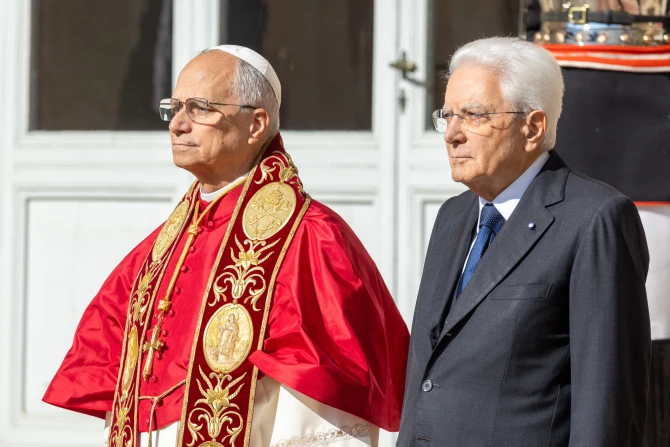In the heart of Spain, within the ancient walls of Ávila, faith and history meet in an event that every year draws pilgrims, devotees, and travelers from around the world. It is October 15th, the day the city celebrates its most illustrious daughter: Saint Teresa the Mystic — reformer, writer, and the first woman ever to be proclaimed a Doctor of the Church.
In a Spain marked by wars, reforms, and inquisitions, a woman was born in 1515 who would forever change the face of Christian spirituality.
Father Emilio Martínez, professor at the Pontifical Theological Faculty Teresianum in Rome, explains:
“We must remember that just a few years before Teresa’s birth, the Protestant Reformation had erupted. All of Lutheran theology was emerging. It quickly became not just a religious movement but also a political one, sparking wars of religion across Europe. Teresa witnesses the suffering of the Church, and in her heart arises a deep desire to lift it up — to heal the wounds inflicted upon it.”
From an early age, Teresa’s strong character and spiritual longing were evident. In Rome, Father Roberto Marini, parish priest of the Basilica of Saint Teresa of Ávila, recalls a childhood episode depicted in a bas-relief inside the church:
“When she was still a child, together with her brother, she ran away from home, wanting to go and be martyred by the Moors. In the bas-relief, we can also see the uncle who caught up with them and brought them back home.”
This story, which Teresa herself recounts, reveals a profound desire that would later mature throughout her life. She once wrote a poem saying, “I die because I do not die.”
As she grew older, Teresa’s faith was tested. At the age of 20, she entered the convent — but it was not the life she had imagined. She endured a long spiritual crisis, mirroring the broader struggles of the Church during her time.
Father Emilio Martínez continues:
“In her foundations, Teresa sought a much simpler environment — reducing the number of nuns in her monasteries and leading a stricter, more isolated life. But not out of love for harsh penance. Rather, so that the nuns could be free and not constantly disturbed by the comings and goings of people.”
Her life in the convent was also marked by illness. Yet through her suffering, something extraordinary occurred — the Transverberation, or mystical piercing of the heart.
Father Roberto Marini explains:
“This is the famous experience we see represented nearby, in Bernini’s Ecstasy of Saint Teresa at the Church of Santa Maria della Vittoria. She described how, in that moment, she felt as though she were dying — yet at the same time experiencing infinite delight, a sweetness so intense that it made her long for that death to be fulfilled.”
Father François-Marie Léthel, professor at the Teresianum and expert on Saint Teresa, compares this mystical grace to that of Saint Francis of Assisi:
“I would say that this transverberation is somewhat like the equivalent of Saint Francis’s stigmata — a special grace of communion with Christ, sharing in His sufferings for a fruitful and greater work.”
Beyond her reforms and foundations, Teresa was also a brilliant writer. Her works — especially The Interior Castle — remain masterpieces of mystical theology.
Father Léthel adds:
“The Interior Castle is a synthesis of all her spirituality. It’s a profound reflection on the words of Jesus: ‘Whoever loves me will keep my word, and my Father will love him, and we will come to him and make our dwelling with him.’ Teresa spoke of the soul as a castle with many rooms, with God dwelling at the center.”
Father Marini further explains:
“It’s a work that describes the path every Christian must take to enter into themselves — a kind of spiritual GPS, a navigator of the soul. You may be feeling sadness, anxiety, or unrest, but Teresa tells you: there’s a depth in all this connected to your relationship with God — whether present or distant, guiding you or being fled from.”
In 1970, Pope Paul VI recognized the universal and enduring value of her teaching, declaring Teresa of Ávila a Doctor of the Church — the first woman to receive this title.
Father Martínez concludes:
“In the Basilica of Saint Peter, as soon as you enter, look to the right and you’ll see the statue of Saint Mother Teresa of Jesus. We call her ‘Saint’ and ‘Mother’ because she is our foundress. Teresa was declared a Doctor of the Church because through her writings she illuminates the spiritual life of every Christian. She is a teacher of the Christian life, guiding us to fulfill the vocation to which we were called at baptism.”
And it is for this reason, more than four centuries later, that the world still looks to St. Teresa of Ávila — mystic, reformer, and Doctor of the Church — as a living teacher of holiness.
Adapted by Jacob Stein. Produced by Alexey Gotovskiy; Camera by Andrea Manna; Video edited by Giada D’Ottavi.




